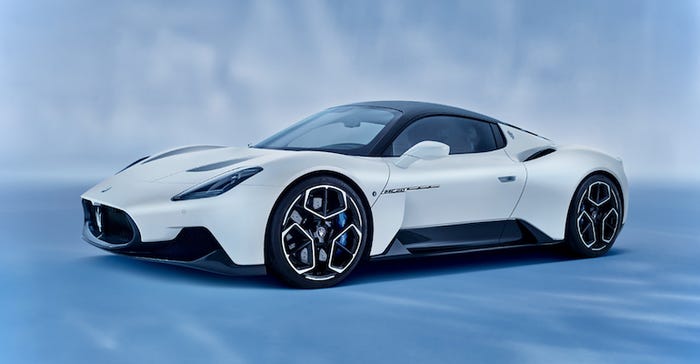Maserati MC20 Supercar Debuts in Gas and Electric Versions
The Maserati MC20's innovative Nettuno twin-turbo V6 will be joined by an available battery-electric drivetrain option.

Maserati MC20Maserati
Maserati's MC20 is an unorthodox supercar, with its twin-turbocharged Nettuno V6 engine that we detailed previously. Aerodynamics dictates a perhaps more conventional approach to the car's design, but chief exterior designer Giovanni Ribotta still enjoyed significant latitude in infusing appropriately distinctive style. He described the process of designing the MC20 in this Q&A.
What does the MC20 mean for Maserati?
“This is the Maserati everyone was waiting for: we needed a model that would take us back to our roots, our ancestral soul. Maserati was founded to build racing cars: developing and designing a supercar is part of our identity, as the marque's history tells us"

After years of working on sedans, SUVs, and GT cars, this was a new major challenge for the style team: where did you start?
“We were asked to create a mid-engine supercar. We approached the project with great care, seeking a balance between performance and form, and we based our work on the canons of Italian and Maserati design, focusing on the ideal trade-off between style and function, meaning performance. This is what we call timeless design, timeless beauty - styling in impeccable taste that doesn't interfere with performance."
When creating the MC20, did you draw inspiration from the many key models in Maserati's history?
“When we began to design the MC20, we immediately looked back over our history and we found inspiration in the world of the Birdcage (Tipo 61), a time when cars' outlines kept very low to the ground; a central fuselage intersected by the wheel arches, with style apparently playing only a secondary role, and the mechanicals prioritized. We also sought inspiration in the most recent example, the MC12: a car developed for the race track and then transferred to the road. In this new project, we thought in terms of a road car from the outset. So our approach was much more streamlined and dynamic than the MC12 concept."
“The car is characterized by a central body that intersects with the wheel arches, generating very pure, dynamic lines. In contrast, in the lower part, given a separate visual identity by the use of carbon fiber, we allowed the engineering to take center stage. There's a clear distinction between the dynamism and purity of the upper section and the technical nature of the lower part."
What was the main challenge when designing a supercar?
“The challenge in designing a supercar was to achieve the right trade-off between the performances fundamental for a car of this type and elegant proportions. For Maserati, and I'd say for the whole Italian design world, proportions signify elegance and sporty prowess. So we tried to strike the right balance by designing a very pure form, with no excesses, that would perfectly match the constraints, the package, the engineering."
The shapes are very different in the top and underside of the car.
“The form is very pure in the upper part of the car and very technical in the lower part. This is where the MC20's performances come from, with the aerodynamics concentrated in the flat floor and the lower part of the car."
“MC20 doesn't have the usual rear fin, because all the aerodynamic load is generated by the underside. This was a great advantage for us in terms of styling: it meant we could avoid aerodynamic appendages that would have detracted from its style."
You were inspired by the great Maserati cars of the past. How and where?
“We studied the story of the Birdcage and the relationship between form and mechanicals. The Birdcage is a car that shows its chassis in places … and in the MC20, thanks to the butterfly doors, you can clearly see the entire inner structure of the chassis”
“However, the world of the MC12 was our inspiration for the more rounded wheel arches. To conclude, the car has a longtail rear. Then, even though this is a mid-engine sports car, we shifted the cabin towards the rear to give a more GT "feel".
As in all Maserati models, the front is very high-impact.
“All Maserati cars have always had very distinctive front ends. They've always been very strong, striking, and aggressive. When you look in your rear-view mirror, you can always tell if the car behind is a Maserati. We opted for vertical light inserts because the horizontal ones have been copied by many other constructors and are no longer so individual. This enabled us to give pride of place to the front grille."
“Half the front grille follows the line of the fuselage, meaning that its shape is pure and dynamic; the lower section, on the other hand, even in terms of material, which is carbon fiber, reveals the structure, the more mechanical part, underneath the skin - everything that enables us to deliver these amazing performances."
With MC20, is Maserati creating a concept for other cars in the future?
“This supercar is a milestone: it's our opportunity to create a real concept, rather like the Alfieri, that provided the basis for generating a whole family of cars. MC20 is the concept for cars to come, but it even enabled us to create a concept in terms of form: what we call sculpted engineering, implemented for the first time with MC20, which is an approach to surfaces we're intending to use again in the future."
A Maserati supercar is a car destined to make its mark.
“A Maserati supercar is a breath-taking proposition. We hadn't had a halo model for some time. MC20 is without a doubt a Maserati: it complies in full with our cars' fundamental design rules, with a form which is, well, sculpted."
“When people see MC20, they're sure to think: this is a Maserati. One of Maserati's characteristics is that it interprets every segment in accordance with its own rules, whether it's a GT, a sedan, or an SUV, or in this case a supercar, it's always handled the Maserati way. For us, it's crucial that when people see it go by, they say: that's a Maserati."
The MC20 project was also carried through at impressive speed.
“I'm very happy with the outcome because the project originated very fast and was completed in extremely short times; from beginning to end, I've really watched the car mature and grow into a Maserati, and this gives me great pleasure. It was absolutely new for us to take on the design of a mid-engine car, almost a racing car. The main difficulty was to create forms that gave a unified, dynamic design. But above all we wanted to design a real Maserati, a car with Italian design, and when I say Italian design I'm talking about the mood, not necessarily the fact that the designer is Italian because mine is an international team. The trade-off between form and function was fundamental because this is a car with immense performances, that had to have elegant looks. And I'm very satisfied with the end result."
About the Author(s)
You May Also Like





